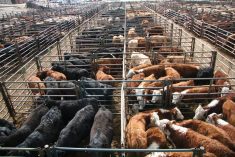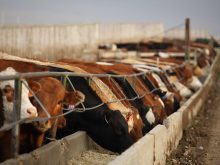For the week ending Feb. 15, western Canadian feeder cattle markets traded $4 to $8 lower on average, compared to the week ending Feb. 1.
There was not sufficient volume during the week of Feb. 2-8 to define the price structure due to tariff fears and adverse winter weather.
Follow all our coverage of the tariffs situation here
Read Also

Breaking down successful winter feeding into six steps
It’s that time of year when it is important to start planning for a cow herd’s winter feeding program. Here are six steps I think are necessary to consider when getting your feed tested.
The following feeder cattle prices are values for the week ending Feb. 15.
In central Saskatchewan, tan mixed steers weighing 980 pounds on light barley and silage diet with full processing records sold for $352.
In central Alberta, lower flesh Charolais steers averaging 950 lb. on light grain and silage diet were quoted at $359.
In southern Manitoba, medium to larger frame Angus blended steers with a mean weight of 705 lb. traded for $415. Similar genetic heifers averaging slightly more than 700 lb. moved through the ring at $370.
For calves lighter than 700 lb., prices during the week ending Feb. 15 were similar to late January.
North of Calgary, Simmental based steers weighing 620 lb. were valued at $495. Run-of-the mill mixed heifers averaging 600 lb. reportedly sold for $417. Good quality steers weighing 500-525 lb. continued to trade in the range of $525-$550, which was unchanged from 14 days earlier.
On Feb. 3, the implementation of U.S. tariffs and Canadian retaliatory measures were delayed for 30 days.
During the first half of February, Alberta fed cattle prices were hovering in the range of $276-$279 per cwt. Break-even pen closeouts are in the range of $260-$265.
The healthy margins have been supportive for feeder cattle prices, but the profitability could quickly turn negative come March if tariffs are implemented on fed cattle exports.

Feedlot operators are selling fed cattle fairly aggressively in an attempt to jump ahead of potential tariffs.
Dressed weights on Alberta steers are down 51 lb. from last year. There is a fear in reloading with replacements too quickly, which has resulted in a softer tone for feeder cattle heavier than 700 pounds.
As we approach the end of February without any updates, we can expect the feeder market to grind lower. In this case, no news is bad news and it will likely be a last minute decision from U.S. president Donald Trump.
If no tariffs are implemented, the fed cattle market will remain firm into April and May. There should be a solid four or five month period of positive margins in the finishing sector.
Market-ready fed cattle supplies on both sides of the border will tighten and dip to seasonal lows during the last half of April and first half of May. This could cause the live cattle futures to trade back up to historical highs.
We’re also expecting the Alberta basis to improve.
The Alberta fed cattle market would need to trade at a premium to U.S. values during the spring due to tighter market-ready supplies. The Alberta fed market would need to slow exports.
Alberta finishing margins will move into negative territory during June and July because the fed cattle break-even price needs to be at $280.
For March delivery, the Lethbridge barley market was hovering around $310 per tonne delivered while central Alberta barley was quoted in the range of $290-$305.
According to Statistics Canada, Canadian barley stocks as of Dec. 31, 2024, were 4.958 million tonnes, down 503,000 tonnes from Dec. 31, 2023.
We’re expecting the barley market to rally $30-$40 per tonne during April and May, which may influence the feeder market. It’s important to note that corn was not on the list of Canadian retaliatory tariffs.
Feeding margins will erode in May due to higher feedgrain values.
March feeder cattle futures were trading $10-$12 off the high on Feb. 13.
On Feb. 1, the U.S. Department of Agriculture’s Animal and Plant Health Inspection Service announced the resumption of feeder cattle imports from Mexico Feb. 1.
We’re looking for a sharp year-over-year increase in U.S. imports of Mexican feeder cattle during March and April. Mexican feeder cattle take about 30-45 days longer to finish.
U.S. imports of Mexican feeder cattle are increasing, and this has contributed to weakness in Western Canada.
The USDA’s January Inventory Report was considered somewhat bearish for feeder cattle.
The U.S. calf crop for 2024 was estimated at 33.529 million head, down only 33,500 head from the 2023 output of 33.563 million head. The output was basically the same as in 2023, and with more Holstein cross feeders moving into feedlots, placements will only be marginally lower in 2025.
The managed money had a record long on the feeder cattle futures on Jan. 21. Since then, the funds have been liquidating their position.
For the week ending Feb. 4, the managed money was a net seller of 946 contracts, bringing their net long position to 26,781 contracts.
The commercials were a net buyer of 387 contracts, resulting in a net short position of 6,304 contracts.
Managed money selling and commercial buying characterize a bearish or downward trending market. We’re expecting the funds to continue liquidating until their long is more manageable, around 10,000 contracts.
The CME composite price is the official cash settlement price for the CME feeder cattle futures at contract final settlement. Figures have been calculated by the CME Group from prices reported by the USDA.
The feeder cattle futures have come off the recent highs but remain in an upward trend. We need to see a close below $253 to break the longer term upward trendline.
Cow-calf producers need to watch this simple technical indicator over the next year. When a market breaks a long-term upward trendline, there is usually a significant move to the downside.
Jerry Klassen is president and founder of Resilient Capital, specializing in proprietary commodity futures trading and market analysis. He can be reached at 204-504-8339 or via his website at resilcapital.com.
















